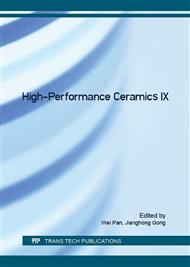[1]
Y. Yan, Z. Huang, S. Dong and D. Jiang, New Route to Synthesize Ultra-Fine Zirconium Diboride Powders Using Inorganic-Organic Hybrid Precursors, J Am Ceram Soc 11(2006) 3585-3588.
DOI: 10.1111/j.1551-2916.2006.01269.x
Google Scholar
[2]
T. Tsuchida, MA-SHS and SPS of ZrB2-ZrC composites, Solid State Ionics 1-4(2004) 215-216.
DOI: 10.1016/j.ssi.2004.05.020
Google Scholar
[3]
X. -G. Wang, W. -M. Guo and G. -J. Zhang, Pressureless sintering mechanism and microstructure of ZrB2–SiC ceramics doped with boron, Scripta Materialia 2(2009) 177-180.
DOI: 10.1016/j.scriptamat.2009.03.030
Google Scholar
[4]
F. Monteverde and A. Bellosi, Efficacy of HfN as sintering aid in the manufacture of ultrahigh- temperature metal diborides-matrix ceramics, Journal of Materials Research 12(2011) 3576-3585.
DOI: 10.1557/jmr.2004.0460
Google Scholar
[5]
Y. Yan, Z. Huang, S. Dong and D. Jiang, Pressureless Sintering of High-Density ZrB2-SiC Ceramic Composites, J Am Ceram Soc 11(2006) 3589-3592.
DOI: 10.1111/j.1551-2916.2006.01270.x
Google Scholar
[6]
K.H. Kim and K.B. Shim, The effect of lanthanum on the fabrication of ZrB2–ZrC composites by spark plasma sintering, Materials Characterization 1(2003) 31-37.
DOI: 10.1016/s1044-5803(03)00055-x
Google Scholar
[7]
R. He, X. Zhang, P. Hu, W. Han and C. Hong, Preparation of YAG gel coated ZrB2–SiC composite prepared by gelcasting and pressureless sintering, Composites Part B: Engineering 54(2013) 307-312.
DOI: 10.1016/j.compositesb.2013.05.039
Google Scholar
[8]
P. MILLET and T. HWANG, Preparation of TiB2 and ZrB2. influence of a mechano-chemical treatment on the borothermic reduction of titania and zirconia, Journal of Materials Science 31(1996) 351-355.
DOI: 10.1007/bf01139151
Google Scholar
[9]
R. Licheri, R. Orrù, C. Musa and G. Cao, Combination of SHS and SPS Techniques for fabrication of fully dense ZrB2-ZrC-SiC composites, Materials Letters 3(2008) 432-435.
DOI: 10.1016/j.matlet.2007.05.066
Google Scholar
[10]
H. Zhao, Y. He and a. Jin, Preparation of Zirconium Boride Powder, J. Am. Ceram. Soc. 78(1995) 2534-2536.
Google Scholar
[11]
Y. Zhang, R. Li, Y. Jiang, B. Zhao, H. Duan, J. Li and Z. Feng, Morphology evolution of ZrB2 nanoparticles synthesized by sol–gel method, Journal of Solid State Chemistry 8(2011) 2047-(2052).
DOI: 10.1016/j.jssc.2011.05.040
Google Scholar
[12]
Y. Xie, T.H. Sanders and R.F. Speyer, Solution-Based Synthesis of Submicrometer ZrB2 and ZrB2–TaB2, J Am Ceram Soc 5(2008) 1469-1474.
Google Scholar
[13]
M. Kakiage, Y. Tominaga, I. Yanase and H. Kobayashi, Synthesis of boron carbide powder in relation to composition and structural homogeneity of precursor using condensed boric acid–polyol product, Powder Technology 221(2012) 257-263.
DOI: 10.1016/j.powtec.2012.01.010
Google Scholar


